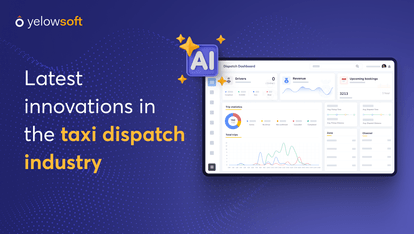For many small taxi operators, growth often feels like chasing a moving target. You work hard to keep your drivers happy, but they leave for bigger platforms offering better pay and perks.
Passengers try your service once, then disappear to competitors with slick apps and seamless rides.
It’s frustrating, but here’s the truth — today’s riders and drivers expect more than just a ride.
They want trust, safety, and convenience. Without tools like real-time tracking, instant bookings, and accurate navigation, it’s hard to deliver that.
Real-time tracking isn’t just about maps. It reassures passengers that their ride is on the way and keeps drivers accountable, making every trip safer.
If you’re still relying on outdated systems, you’re giving competitors an open lane to overtake you.
So, how to grow a taxi business? The answer is simple: you must embrace technology such as taxi dispatch software and offer the modern experience people already expect.
In this blog, we will mention the challenges that taxi businesses face in attracting drivers and riders. We will also ponder the effective ways to attract drivers and riders and grow your taxi business successfully.
So, let’s start by exploring the challenges first.
Challenges of Drivers and Riders: The Reason Why Taxi Businesses are Unable to Retain Them
Growing a taxi business network isn’t just about adding more cars on the road. It’s about creating a system where both drivers and passengers feel valued. Unfortunately, many startups and small taxi businesses struggle to achieve this balance. Here are some key challenges they face:
Challenges Drivers Face
1. Frequent Fare Disputes and Payment Issues
Drivers want to feel secure about their earnings. When fares are unclear or payments are delayed, frustration grows. Frequent disputes with passengers over pricing not only create tension but also push drivers to seek other platforms with transparent systems. Fair, timely payments are critical to keeping drivers motivated and loyal to your service.
2. Idle Cars or Overloaded Drivers
Poor ride allocation often leaves some drivers sitting idle while others are overwhelmed with bookings. This imbalance lowers earnings for idle drivers and burns out the ones constantly on the move. Without smart ride assignment, both groups end up dissatisfied, and overall efficiency drops.
3. Lack of Safety Features
Drivers often feel vulnerable during late-night rides or in unfamiliar areas. Without built-in safety features like SOS buttons or real-time tracking, they worry about their security. This fear can discourage drivers from taking certain trips or working at peak hours, affecting availability and revenue.
4. Poor Communication with Dispatchers
When drivers struggle to get support during emergencies or technical issues, it creates distrust. Slow responses or confusing instructions lead to missed rides, unhappy customers, and driver frustration. Clear, quick communication tools are essential for smooth operations.
5. Limited Earning Opportunities
Many drivers leave small taxi networks because they feel their growth is capped. Without incentives like bonuses for peak hours or loyalty programs, they see no reason to stay. Competing platforms often lure them away with better earning potential.
Challenges Riders Face
1. Anxiety Due to No Live Tracking or ETAs
Passengers feel uneasy when they can’t see their driver’s location or estimated arrival time. Not knowing when the ride will arrive causes stress and distrust. Live tracking isn’t just a feature — it’s a necessity for safety and peace of mind.
2. High Driver Cancellation Rates
Few things frustrate passengers more than last-minute cancellations. When drivers frequently cancel rides, it signals unreliability. Passengers lose confidence and turn to competitors offering a more dependable experience.
3. High No-Show Rates
On the other hand, passengers who book rides and never show up waste drivers’ time and reduce availability for others. Without a system to manage or discourage no-shows, both parties end up frustrated, and revenue suffers a loss.
4. Poor Customer Support During Urgent Situations
When passengers encounter issues — such as lost items, safety concerns, or billing errors — they expect prompt, helpful support. Poor or delayed responses damage trust and make riders feel unheard. Strong customer service can turn a bad experience into loyalty, while weak service pushes passengers away.
5. Limited Payment Options
Today’s riders expect flexibility in how they pay. When only cash or a single digital option is available, it creates inconvenience. Offering multiple payment methods makes the process seamless and builds trust in your service.
Effective Ways to Attract Drivers and Riders and Grow Your Taxi Business
Taxi businesses often struggle to balance the needs of drivers and riders. The right strategies and technology can bridge this gap. Below are effective solutions to address key pain points, helping businesses grow while delivering seamless experiences.
Solutions for Driver Challenges
1. Fair and Transparent Payments
Drivers leave when earnings feel inconsistent or unfair. Automating fare calculations solves this issue. With digital payments and clear earning statements, drivers can track every ride and payout. Instant settlements build trust and reduce disputes. When drivers see transparency, they focus more on service and less on questioning the system. It’s a direct path to retention and loyalty.
2. Smart Ride Allocation
Idle cars hurt earnings, while overload causes burnout. A smart dispatch system distributes rides evenly based on location and availability. This balance ensures drivers don’t wait long for their next fare while avoiding overwhelming busy drivers. A well-managed ride allocation system keeps the workforce productive, motivated, and ready to deliver consistent service to passengers.
3. Driver Performance Insights
Without feedback, drivers can’t improve. Driver performance tracking helps them understand their strengths and weaknesses. Metrics like on-time arrivals, trip completion rates, and customer ratings guide drivers to enhance service quality. With regular feedback, drivers stay accountable and competitive. This also helps businesses identify top performers and provide targeted support where needed.
4. Flexible Scheduling Options
Rigid schedules push drivers away. Offering flexible working hours attracts more drivers to the platform. With a feature that allows drivers to set availability, businesses can keep their fleet active around the clock. Flexibility helps businesses meet demand spikes while giving drivers control over their work-life balance.
Solutions for Rider Challenges
1. Real-Time Tracking and ETAs
Passengers feel anxious without visibility of their ride. Live tracking and accurate ETAs create trust and peace of mind. Riders know exactly where their driver is and when they’ll arrive. This transparency improves safety perceptions and significantly reduces support calls. For riders, visibility isn’t just a feature; it’s a necessity for confidence and convenience.
2. Reduce Driver Cancellations
High cancellation rates damage a business’s reputation. A strong cancellation policy paired with incentives motivates drivers to complete rides. Smart algorithms can also match riders with nearby drivers to reduce wait times. When cancellations decrease, reliability improves, encouraging passengers to return and recommend the service to others.
3. Efficient Customer Support
Riders expect quick help during issues like lost items or payment errors. A 24/7 in-app support system ensures they get timely solutions. Features like chat support, quick complaint logging, and automated updates make the process smooth. When riders feel heard and supported, they stay loyal to the brand.
4. Personalized Ride Options
Different passengers have different needs. Offering varied services such as premium cars, budget rides, or EV options widens the customer base. This variety ensures that every rider finds a service that fits their budget and preference, increasing overall satisfaction and brand reach.
Conclusion
Growing a taxi network is about creating harmony between driver satisfaction and rider experience.
When drivers trust the platform and feel valued, they deliver better service. When riders feel safe, informed, and supported, they keep coming back.
By addressing common challenges with smart technology like automated dispatch, real-time tracking, and seamless support, small taxi businesses can compete with giants.
These solutions build transparency, reliability, and loyalty on both sides. The future of your taxi business depends on how well you adapt today.
Invest in tools and strategies that make every ride smooth and every interaction meaningful.
Start Attracting Your Drivers and Customers Straight Away with Yelowsoft




